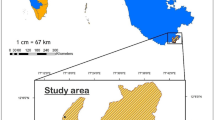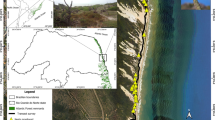Abstract
The Alpine Rock Ptarmigan (Lagopus muta helvetica)—which is adapted to arctic and alpine environments—is suspected to be vulnerable to climate warming, but direct evidence is limited. Microclimates within a landscape may allow species to exist in regions where the general climate appears to be unsuitable for them. We therefore investigated the diversity of microclimates in alpine habitats used by the Alpine Rock Ptarmigan in summer, and we examined whether Alpine Rock Ptarmigan select places with a microclimate that facilitates heat dissipation during summer days. The study was done in the Haute-Savoie (northern French Alps), where ptarmigan have been equipped with radio transmitters, thus allowing direct observations. We measured the three microclimate variables which determine the thermal environment of an animal: ambient temperature (ground and air temperature), which defines the temperature gradients between the animal and the environment; wind speed, which determines convection; and solar radiation, which determines radiation uptake. Additional measurements at four contrasting microtopographic sites at five locations and at two random sites in July and August showed that the typical habitat of the Alpine Rock Ptarmigan offered a wide variety of microclimates over very short distances, particularly on hot summer days. Compared with control sites at 5 m and 30 m, Alpine Rock Ptarmigan selected places with a particular microtopography and microclimate: slightly cooler places in the shade that were protected from the wind; often small, north-facing depressions with a medium amount of rocks and diverse ground cover. The places selected by ptarmigan during hot summer days conformed well to the requirements of both heat dissipation and predator avoidance, and also offered food.
Zusammenfassung
Mikroklima und Mikrohabitatwahl beim Alpenschneehuhn ( Lagopus muta helvetica ) im Sommer
Das Alpenschneehuhn (Lagopus muta helvetica) ist an arktische und alpine Lebensräume angepasst. Deshalb wird es als empfindlich gegenüber den Auswirkungen der Klimaerwärmung betrachtet, doch sind direkte Nachweise selten. Mikroklimas in speziellen Habitaten können es Arten erlauben, in Gebieten vorzukommen, deren generelles Klima ungeeignet ist. Wir untersuchten die Vielfalt der Mikroklimas in den alpinen Habitaten des Alpenschneehuhns im Sommer und prüften, ob das Alpenschneehuhn an Sommertagen Plätze aufsucht, die eine gute Wärmeableitung ermöglichen. Die Studie fand in den französischen Alpen der Haute-Savoie statt, wo besenderte Vögel direkte Beobachtungen ermöglichten. Wir maßen die drei Mikroklimavariablen, die die thermische Umgebung des Vogels bestimmen: (a) Luft- und Bodentemperatur, die den thermischen Gradienten zwischen Tier und Umgebung bestimmen, (b) Windgeschwindigkeit, die die Konvektion bestimmt und (c) Sonneneinstrahlung. Zusätzliche Messungen an vier kontrastierenden mikrotopographischen Orten und an zufällig ausgewählten Orten ergaben, dass typische Habitate des Alpenschneehuhns eine grosse Vielfalt von Mikroklimas über kurze Distanzen bieten, vor allem an warmen Sommertagen. Die Alpenschneehühner suchten Plätze auf, die sich durch eine besondere Mikrotopographie und eine spezielles Mikroklima gegenüber Kontrollplätzen in 5 m und 30 m Distanz auszeichneten: etwas kühlere Plätze im Schatten und windgeschützt, oft in kleinen Mulden, die gegen Norden geöffnet waren, an Orten mit einer vielfältigen Bodenbedeckung mit Felsbrocken. Solche Plätze ermöglichen nicht nur eine gute Wärmeableitung, sondern sind auch ausgezeichnet zur Feindvermeidung und bieten Nahrung.




Similar content being viewed by others
References
Bakken GS, Buttemer WA, Dawson WR, Gates DM (1981) Heated taxidermic mounts: a means of measuring the standard operative temperature affecting small animals. Ecology 62:311–318
Bakken GS, Murphy MT, Erskine DJ (1991) The effect of wind and air temperature on metabolism and evaporative water loss rates of Dark-eyed Juncos, Junco hyemalis: a standard operative temperature scale. Physiol Zool 64:1023–1049
Bates D (2005) Fitting linear mixed models in R—using the lme4 package. R News 5:27–30
Baur B, Baur A (2013) Snails keep the pace: shift in upper elevation limit on mountain slope as response to climate warming. Can J Zool 91:596–599
Bennie J, Huntley B, Wiltshire A, Hill MO, Baxter R (2008) Slope, aspect and climate: spatially explicit and implicit models of topographic microclimate in chalk grassland. Ecol Modell 216:47–59. doi:10.1016/j.ecolmodel.2008.04.010
Bertermann C, Weber-Spoarenberg C, Pechura A, Renard AI, Bergmann HH (1998) Zur Ernährung von Alpenschneehühnern Lagopus mutus helveticus im Sommer. Egretta 41:15–26
Carr JM, Lima SL (2014) Wintering birds avoid warm sunshine: predation and the costs of foraging in sunlight. Oecologia 174:713–721. doi:10.1007/s00442-013-2804-7
Chamberlain D, Negro M, Caprio E, Rolando A (2013) Assessing the sensitivity of alpine birds to potential future changes in habitat and climate to inform management strategies. Biol Cons 167:127–135
Desmet JF (1988) Le lagopède alpin (Lagopus mutus helveticus, Thieneman 1829) dans les Alpes françaises septentrionales: descriptif de l’habitat en haute vallée du Giffre (Haute-Savoie, France). Actes du Colloque Galliformes de Montagne 129–161
Desmet JF (1994) Lagopède alpin. In: Yeatman-Berthelot D, Jarry G (eds) Nouvel Atlas des oiseaux nicheurs de France 1985–1989. Société Ornithologique de France, Paris, pp 216–217
Desmet JF (2012) Lagopède alpin: eléments d’appréciation du succès de la reproduction en 2012. Rapport interne GRIFEM/ONCFS Sd74. Office National de la Chasse e de la Faune Sauvage, Paris
Desmet JF (in press) Quel avenir pour le Lagopède alpin en France? In: Gauthier-Clerc M, Mesleard F, Blondel J (ed) Sciences de la conservation. De Boeck, Brussels
Favaron M, Scherini GC, Preatoni D, Tosi G, Wauters LA (2006) Spacing behaviour and habitat use of rock ptarmigan (Lagopus mutus) at low density in the Italian Alps. J Ornithol 147:618–628. doi:10.1007/s10336-006-0087-z
Gillingham PK, Huntely B, Kunin WE, Thomas CD (2012) The effect of spatial resolution on projected responses to climate warming. Divers Distrib 18:990–1000
Glutz von Blotzheim UN, Bauer K, Bezzel E (1973) Handuch der Vögel Mitteleuropas, vol 5: Galliformes und Gruiformes. Akademische Verlagsgesellschaft, Frankfurt
Grabherr G, Gottfried M, Pauli H (1994) Climate effects on mountain plants. Nature 369:448
Imperio S, Bionda R, Viterbi R, Provenzale A (2013) Climate change and human disturbance can lead to local extinction of Alpine Rock Ptarmigan: new insight from the western Italian Alps. PLoS ONE 8:e81598. doi:10.1371/journal.pone.0081598
Johnson R (1968) Temperature regulation in the white-tailed ptarmigan, Lagopus leucurus. Comp Biochem Physiol 24:1003–1014
Keller V, Gerber A, Schmid H, Volet B, Zbinden N (2010) Rote Liste Brutvögel. Gefährdete Arten der Schweiz, Stand 2010. Umwelt-Vollzug Nr. 1019. Bundesamt für Umwelt, Bern, und Schweizerische Vogelwarte, Sempach
Körner C (2003) Alpine plant life: functional plant ecology of high mountain ecosystems, 2nd edn. Springer, Berlin, p 349
La Sorte FA, Jetz W (2010) Avian distributions under climate change: towards improved projections. J Exp Biol 213:862–869. doi:10.1242/jeb.038356
Lenoir J, Gégout JC, Marquet PA, De Ruffray P, Brisse H (2008) A significant upward shift in plant species optimum elevation during the 20th century. Science 320:1768–1771. doi:10.1126/science.1156831
Mani M (1968) Ecology and biogeography of high altitude insects. W. Junk, The Hague, pp 32–42. doi: 10.1007/978-94-017-1339-9
Marti C, Bossert A (1985) Beobachtungen zur Sommeraktivität und Brutbiologie des Alpenschneehuhns Lagopus mutus im Aletschgebiet (Wallis). Ornithol Beob 82:153–168
Mortensen A, Blix AS (1986) Seasonal changes in resting metabolic rate and mass-specific conductance in Svalbard Ptarmigan, Norwegian Rock Ptarmigan and Norwegian Willow Ptarmigan. Ornis Scand 17:8–13
Nievergelt B (1965) Der Alpensteinbock (Capra ibex) in seinem Lebensraum. Dissertation. University of Zürich, Zürich
Novoa C, Desmet JF (2011) Demographic traits of two alpine populations of Rock Ptarmigan. In: Sandercock BK, Martin K, Segelbacher G (eds) Ecology conservation and management of grouse. University of California Press, Los Angeles, pp 267–280
Novoa C, Desmet JF, Muffat-Joly B, Arvin-Bérod M, Belleau E, Birck C, Losinger I (2014) Le lagopède alpin en Haute-Savoie, biologie des populations et impact des activités humaines. ONCFS/Asters/GRIFEM, Paris
Pauli H, Gottfried M, Grabherr G (2003) Effects of climate change on the alpine and nival vegetation of the Alps. J Mountain Ecol 7:9–12
R Development Core Team (2012) R: a language and environment for statistical computing. R Foundation for Statistical Computing, Vienna
Revermann R, Schmid H, Zbinden N, Spaar R, Schröder B (2012) Habitat at the mountain tops: how long can Rock Ptarmigan (Lagopus muta helvetica) survive rapid climate change in the Swiss Alps? A multi-scale approach. J Ornithol 153:891–905. doi:10.1007/s10336-012-0819-1
Scherini G, Tosi G, Wauters LA (2003) Social behaviour, reproductive biology and breeding success of Alpine Rock Ptarmigan Lagopus mutus helveticus in northern Italy. Ardea 91:11–24
Scherrer D, Körner C (2010) Infra-red thermometry of alpine landscapes challenges climatic warming projections. Glob Chang Biol 16:2602–2613. doi:10.1111/j.1365-2486.2009.02122.x
Schweiger AK, Nopp-Mayr U, Zohmann M (2012) Small-scale habitat use of black grouse (Tetrao tetrix L.) and rock ptarmigan (Lagopus muta helvetica Thienemann) in the Austrian Alps. Eur J Wildl Res 58:35–45. doi:10.1007/s10344-011-0537-7
Smith SE, Gregory RD, Anderson BJ, Thomas CD (2013) The past, present and potential future distribution of cold-adapted bird species. Divers Distrib 19:352–362. doi:10.1111/ddi.12025
Speakman JR, Król E (2010) Maximal heat dissipation capacity and hyperthermia risk: neglected key factors in the ecology of endotherms. J Anim Ecol 79:726–746. doi:10.1111/j.1365-2656.2010.01689.x
Suggitt AJ, Gillingham PK, Hill JK, Huntley B, Kunin WE, Roy DB, Thomas CD (2011) Habitat microclimates drive fine-scale variation in extreme temperatures. Oikos 120:1–8
Veghte JH, Herreid CF II (1965) Radiometric determination of feather insulation and metabolism of arctic birds. Physiol Zool 38:267–275
Vittoz P, Cherix D, Gonsetz Y, Lubini V, Maggini R, Zbinden N, Zumbach S (2013) Climate change impacts on biodiversity in Switzerland: a review. J Nature Cons 21:154–162
Walsberg G, Wolf B (1995) Solar heat gain in a desert rodent: unexpected increases with wind speed and implications for estimating the heat balance of free-living animals. J Comp Physiol B 165:306–314
Walther G, Beissner S, Burga C (2005) Trends in the upward shift of alpine plants. J Veg Sci 16:541–548
West GC (1972) Seasonal differences in resting metabolic rate of Alaskan ptarmigan. Comp Biochem Physiol A Comp Physiol 42:867–876
Wilson J (1959) Notes on wind and its effects in arctic-alpine vegetation. J Ecol 47:415–427
Wilson S, Martin K (2008) Breeding habitat selection of sympatric White-tailed, Rock and Willow Ptarmigan in the southern Yukon Territory, Canada. J Ornithol 149:629–637. doi:10.1007/s10336-008-0308-8
Wolf B, Walsberg G (1996) Thermal effects of radiation and wind on a small bird and implications for microsite selection. Ecology 77:2228–2236
Wolfe D, Larsson L (2011) Investigating the importance of thermal refugia for white-tailed ptarmigan at the southern extent of their range. Grouse News 41:22–24
Young K, Woo M, Edlund S (1997) Influence of local topography, soils, and vegetation on microclimate and hydrology at a high Arctic site, Ellesmere Island, Canada. Arct Alp Res 29:270–284
Zohmann M, Wöss M (2008) Spring density and summer habitat use of alpine rock ptarmigan Lagopus muta helvetica in the southeastern Alps. Eur J Wildl Res 54:379–383. doi:10.1007/s10344-007-0149-4
Zohmann M, Pennerstorfer J, Nopp-Mayr U (2013) Modelling habitat suitability for alpine rock ptarmigan (Lagopus muta helvetica) combining object-based classification of IKONOS imagery and Habitat Suitability Index modelling. Ecol Modell 254:22–32. doi:10.1016/j.ecolmodel.2013.01.008
Acknowledgments
We warmly thank the group ONCFS Sd74/GRIFEM for their collaboration and for allowing us to track the birds they equipped with radiotransmitters. We thank Roland and Elisabeth Mogenier for their hospitality at the refuge de Sales. We thank Christian Marti for introducing LV and CP to the ptarmigan and for many helpful comments when planning the study. We thank Beat Naef-Daenzer, Christian Marti, and Niklaus Zbinden, as well as three reviewers for many helpful comments on the manuscript.
Author information
Authors and Affiliations
Corresponding author
Additional information
Communicated by F. Bairlein.
Electronic supplementary material
Below is the link to the electronic supplementary material.
Rights and permissions
About this article
Cite this article
Visinoni, L., Pernollet, C.A., Desmet, JF. et al. Microclimate and microhabitat selection by the Alpine Rock Ptarmigan (Lagopus muta helvetica) during summer. J Ornithol 156, 407–417 (2015). https://doi.org/10.1007/s10336-014-1138-5
Received:
Revised:
Accepted:
Published:
Issue Date:
DOI: https://doi.org/10.1007/s10336-014-1138-5




